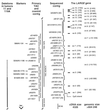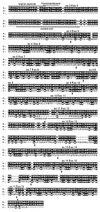The human LARGE gene from 22q12.3-q13.1 is a new, distinct member of the glycosyltransferase gene family
- PMID: 9892679
- PMCID: PMC15182
- DOI: 10.1073/pnas.96.2.598
The human LARGE gene from 22q12.3-q13.1 is a new, distinct member of the glycosyltransferase gene family
Abstract
Meningioma, a tumor of the meninges covering the central nervous system, shows frequent loss of material from human chromosome 22. Homozygous and heterozygous deletions in meningiomas defined a candidate region of >1 Mbp in 22q12.3-q13.1 and directed us to gene cloning in this segment. We characterized a new member of the N-acetylglucosaminyltransferase gene family, the LARGE gene. It occupies >664 kilobases and is one of the largest human genes. The predicted 756-aa N-acetylglucosaminyltransferase encoded by LARGE displays features that are absent in other glycosyltransferases. The human like-acetylglucosaminyltransferase polypeptide is much longer and contains putative coiled-coil domains. We characterized the mouse LARGE ortholog, which encodes a protein 97.75% identical with the human counterpart. Both genes reveal ubiquitous expression as assessed by Northern blot analysis and in situ histochemistry. Chromosomal mapping of the mouse gene reveals that mouse chromosome 8C1 corresponds to human 22q12.3-q13.1. Abnormal glycosylation of proteins and glycosphingolipids has been shown as a mechanism behind an increased potential of tumor formation and/or progression. Human tumors overexpress ganglioside GD3 (NeuAcalpha2,8NeuAcalpha2, 3Galbeta1,4Glc-Cer), which in meningiomas correlates with deletions on chromosome 22. It is the first time that a glycosyltransferase gene is involved in tumor-specific genomic rearrangements. An abnormal function of the human like-acetylglucosaminyltransferase protein may be linked to the development/progression of meningioma by altering the composition of gangliosides and/or by effect(s) on other glycosylated molecules in tumor cells.
Figures




Similar articles
-
Characterization of a new member of the human beta-adaptin gene family from chromosome 22q12, a candidate meningioma gene.Hum Mol Genet. 1994 Aug;3(8):1393-9. doi: 10.1093/hmg/3.8.1393. Hum Mol Genet. 1994. PMID: 7987321
-
1p and 3p deletions in meningiomas without detectable aberrations of chromosome 22 identified by comparative genomic hybridization.Genes Chromosomes Cancer. 1997 Dec;20(4):419-24. Genes Chromosomes Cancer. 1997. PMID: 9408760
-
Identification of new members of the Gas2 and Ras families in the 22q12 chromosome region.Genomics. 1996 Dec 15;38(3):247-54. doi: 10.1006/geno.1996.0625. Genomics. 1996. PMID: 8975699
-
Analysis of chromosome 22 loci in meningioma. Alterations in the leukemia inhibitory factor (LIF) locus.Mol Chem Neuropathol. 1994 Feb-Apr;21(2-3):189-217. doi: 10.1007/BF02815351. Mol Chem Neuropathol. 1994. PMID: 7916188 Review.
-
The molecular genetics of meningiomas.Brain Pathol. 1990 Sep;1(1):19-24. doi: 10.1111/j.1750-3639.1990.tb00634.x. Brain Pathol. 1990. PMID: 1688296 Review.
Cited by
-
Metabolic Engineering of Glycofusion Bispecific Antibodies for α-Dystroglycanopathies.Antibodies (Basel). 2024 Oct 7;13(4):83. doi: 10.3390/antib13040083. Antibodies (Basel). 2024. PMID: 39449325 Free PMC article.
-
The role of defective glycosylation in congenital muscular dystrophy.Glycoconj J. 2004;20(5):291-300. doi: 10.1023/B:GLYC.0000033626.65127.e4. Glycoconj J. 2004. PMID: 15229394 Review.
-
Genome-wide association study and biological pathway analysis of the Eimeria maxima response in broilers.Genet Sel Evol. 2015 Nov 25;47:91. doi: 10.1186/s12711-015-0170-0. Genet Sel Evol. 2015. PMID: 26607727 Free PMC article.
-
Identification, characterization, and biosynthesis of a novel N-glycan modification in the fruiting body of the basidiomycete Coprinopsis cinerea.J Biol Chem. 2010 Apr 2;285(14):10715-23. doi: 10.1074/jbc.M109.076075. Epub 2010 Jan 8. J Biol Chem. 2010. PMID: 20061575 Free PMC article.
-
Residual laminin-binding activity and enhanced dystroglycan glycosylation by LARGE in novel model mice to dystroglycanopathy.Hum Mol Genet. 2009 Feb 15;18(4):621-31. doi: 10.1093/hmg/ddn387. Epub 2008 Nov 18. Hum Mol Genet. 2009. PMID: 19017726 Free PMC article.
References
-
- Dumanski J P. Neuropathol Appl Neurobiol. 1996;22:412–417. - PubMed
-
- Ruttledge M H, Xie Y-G, Han F-Y, Peyrard M, Collins V P, Nordenskjöld M, Dumanski J P. Genes Chromosomes Cancer. 1994;10:122–130. - PubMed
-
- Fukuda M, Hindsgaul O. In: Molecular Glycobiology. Hames B D, Glover D M, editors. Oxford: Oxford Univ. Press; 1994.
Publication types
MeSH terms
Substances
Associated data
- Actions
- Actions
Grants and funding
LinkOut - more resources
Full Text Sources
Other Literature Sources
Molecular Biology Databases
Miscellaneous

